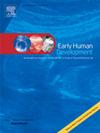Maternal involvement and the language environment in the neonatal intensive care unit (NICU) – a cohort study
IF 2
3区 医学
Q2 OBSTETRICS & GYNECOLOGY
引用次数: 0
Abstract
Background
Preterm infants are at increased risk for language delays. Increased word exposure in the NICU is associated with increased child language skills at 2 years. Additionally, increased maternal involvement in infant care in the NICU is associated with improved outcomes.
Aims
To examine associations between maternal involvement in the NICU and early infant language exposures and vocalizations.
Study design
Outcome data were obtained for the control arm of a larger RCT at Women & Infant's Hospital NICU from January 2013 to August 2016 which enrolled infants < 32 weeks gestational age. Audio environment was captured and analyzed for adult word count (AWC), child vocalizations (CV) and conversational turns (CT) at 32-, 34- and 36-weeks PMA. Infant chart was reviewed for total hours of maternal involvement (visitation, skin-to-skin contact, holding, touching, bedside care and feeding participation) per recording day.
Results
As infant gestational age increased, maternal feeding involvement and infant holding increased, while skin-to-skin care decreased. Aggregate counts of maternal involvements over all recording days showed 51 % of mothers participated in 5–6 involvements and 4 % in 0 involvements. Negative binomial model showed that for every stepwise increase in maternal involvement, there was a 116 % increase (rate ratio 2.16; 1.78–2.62; p < 0.0001) in AWCs and a subsequent 74 % increase (rate ratio 1.74; 1.47–2.05, p < 0.0001) in CTs over the 3 recordings.
Conclusions
Infants of mother with increased involvement experienced increased exposure to AWC and responded with increased CTs. Increasing opportunities and types of parental care involvement are ideal methods of fostering early language development.
新生儿重症监护病房(NICU)的母亲参与和语言环境——一项队列研究
背景:早产儿语言迟缓的风险增加。新生儿重症监护室中增加的文字接触与儿童2岁时语言技能的提高有关。此外,在新生儿重症监护室中,增加母亲参与婴儿护理与改善预后有关。目的探讨母亲在新生儿重症监护室的参与与婴儿早期语言接触和发声之间的关系。研究设计:结果数据来自于Women &;2013年1月至2016年8月,婴儿医院NICU招收婴儿;32周胎龄。在32周、34周和36周时,采集并分析成人单词计数(AWC)、儿童发声(CV)和会话回合(CT)的音频环境。检查每个记录日产妇参与婴儿的总小时数(探视、皮肤接触、抱着、抚摸、床边护理和喂养参与)。结果随着婴儿胎龄的增加,母亲的喂养参与和婴儿的拥抱增加,而皮肤对皮肤的护理减少。在所有记录日中,母亲参与的总数显示,51%的母亲参与了5-6次参与,4%的母亲参与了0次参与。负二项模型显示,每一步增加产妇参与,增加116%(比率比2.16;1.78 - -2.62;p & lt;0.0001),随后增加74%(比率比1.74;1.47-2.05, p <;0.0001)。结论母亲参与程度越高,婴儿接触AWC的几率越大,ct的反应也越明显。增加父母照顾的机会和类型是促进早期语言发展的理想方法。
本文章由计算机程序翻译,如有差异,请以英文原文为准。
求助全文
约1分钟内获得全文
求助全文
来源期刊

Early human development
医学-妇产科学
CiteScore
4.40
自引率
4.00%
发文量
100
审稿时长
46 days
期刊介绍:
Established as an authoritative, highly cited voice on early human development, Early Human Development provides a unique opportunity for researchers and clinicians to bridge the communication gap between disciplines. Creating a forum for the productive exchange of ideas concerning early human growth and development, the journal publishes original research and clinical papers with particular emphasis on the continuum between fetal life and the perinatal period; aspects of postnatal growth influenced by early events; and the safeguarding of the quality of human survival.
The first comprehensive and interdisciplinary journal in this area of growing importance, Early Human Development offers pertinent contributions to the following subject areas:
Fetology; perinatology; pediatrics; growth and development; obstetrics; reproduction and fertility; epidemiology; behavioural sciences; nutrition and metabolism; teratology; neurology; brain biology; developmental psychology and screening.
 求助内容:
求助内容: 应助结果提醒方式:
应助结果提醒方式:


